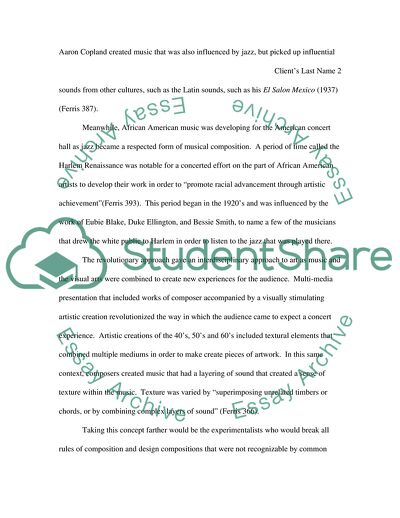
- Home
- Free Samples
- Premium Essays
- Editing Services
- Extra Tools
- Essay Writing Help
- About Us
- Studentshare
- Subjects
- Miscellaneous
- American Music History
American Music History - Essay Example

- Subject: Miscellaneous
- Type: Essay
- Level: Masters
- Pages: 4 (1000 words)
- Downloads: 0
- Author: vabshire
Extract of sample "American Music History"
ing music with the artistic aesthetics of the modernists, the generally accepted theories were abstracted until the music was an experience that had never before been achieved. The evolutionary approach was developed as the influences of mainstream music became integrated into professional compositions intended for the stage. One such example of this is George Gershwin’s Rhapsody in Blue (1924). The piece was a beautifully complex work that combined honored traditions with the influences of jazz.
Critics were unable to determine how to judge the piece as it was “too jazzy for concert music, but unacceptable as jazz because it involved no improvisation”(Ferris 385). Aaron Copland created music that was also influenced by jazz, but picked up influential Meanwhile, African American music was developing for the American concert hall as jazz became a respected form of musical composition. A period of time called the Harlem Renaissance was notable for a concerted effort on the part of African American artists to develop their work in order to “promote racial advancement through artistic achievement”(Ferris 393).
This period began in the 1920’s and was influenced by the work of Eubie Blake, Duke Ellington, and Bessie Smith, to name a few of the musicians that drew the white public to Harlem in order to listen to the jazz that was played there. The revolutionary approach gave an interdisciplinary approach to art as music and the visual arts were combined to create new experiences for the audience. Multi-media presentation that included works of composer accompanied by a visually stimulating artistic creation revolutionized the way in which the audience came to expect a concert experience.
Artistic creations of the 40’s, 50’s and 60’s included textural elements that combined multiple mediums in order to make create pieces of artwork. In this same context, composers created music that had a layering of sound that created a sense of texture
...Download file to see next pages Read MoreCHECK THESE SAMPLES OF American Music History
Classical Music Performed by Noted Musician Yo-Yo Ma
Edward Kennedy Ellington
British Invasion and the Folk Revival
Buddy Holly
History of Mexican music
Music as a Medium of Social Protest in America
The Life of Duke Ellington
American Music Genres History

- TERMS & CONDITIONS
- PRIVACY POLICY
- COOKIES POLICY